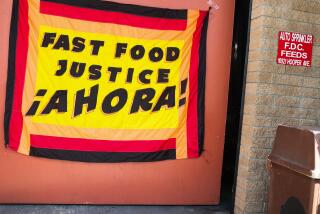Putting health on the menu
A new public health measure took effect July 1 in New York City, requiring fast-food and chain restaurants to post calorie information on their menu boards. In California, a similar proposal, SB 1420, introduced by state Sens. Alex Padilla (D-Pacoima) and Carole Migden (D-San Francisco), is being debated in the Legislature. Although the restaurant industry has lobbied hard for years against menu labeling, it’s worth noting that none of the Burger Kings, Wendy’s or KFCs in Manhattan have suddenly gone out of business.
What has changed is that New Yorkers are now aware of some surprising facts. They can easily see, for example, that a large order of fries and a cheeseburger at McDonald’s has fewer calories than a blueberry muffin and a venti mocha Frappuccino at Starbucks. Prominently giving such information to consumers -- before they place an order -- isn’t going to end California’s obesity epidemic. But it’s a good place to start.
The restaurant chains and fast-food firms argue that mandatory menu-labeling laws restrict their freedom to do business. That’s true. But so do laws requiring them to pay a higher minimum wage, post health inspection grades and prohibit smoking -- all of which they vigorously opposed. For more than a century, industry groups in the U.S. have also fought against food-safety and product-labeling laws. Since the days of President Theodore Roosevelt, a strong counter-argument has been made: The health of the American people is more important than allowing companies to do as they please.
The grim statistics of the nation’s obesity epidemic give a sense of the public health disaster that’s unfolding. Two-thirds of the adults in the United States are obese or overweight. Obesity has been linked to heart disease, high blood pressure, cancer, strokes, asthma, diabetes and reduced life expectancy. According to the Centers for Disease Control and Prevention, obesity is now second only to smoking among the leading causes of preventable death.
And the health of American children is also threatened. During the last 30 years, the obesity rate among American preschoolers has roughly doubled. Among children age 6 to 11, it has tripled. A study of obese children in the U.S., reviewed by the Institute of Medicine, found that 85% already had one or more serious risk factors for cardiovascular disease. The oldest children in the study were 10.
Since 1994, federal law has required nutritional labels on packaged foods. That labeling law makes it possible for consumers shopping at stores to choose products on the basis of their ingredients and calorie levels. Fast-food and chain restaurants have thus far managed to avoid such a legal requirement, despite the fact that almost half the money Americans spend on food is spent at restaurants.
The fast-food and restaurant chains will have little difficulty offering the calorie information. Many items on their menus, such as chicken nuggets and French fries, are manufactured at enormous industrial facilities that produce foods for sale in uniform, standardized portions. Their calorie content can easily and reliably be ascertained. The success of fast-food and chain restaurants is largely a result of the ability to distribute mass-produced, standardized meals. With so few of their menu items being made from scratch, these restaurants are uniquely capable of putting the calorie content of their meals on menus.
Despite industry complaints about “food police” and the “nanny state,” SB 1420 doesn’t ban any foods or prevent you from buying a “Chicken Fiesta Taco Salad” at Taco Bell (790 calories) or a “Western Bacon Six-Dollar Burger” at Carl’s Jr. (1,130 calories). But it might make you think twice about eating them every day.
Mandatory menu labeling actually promotes free enterprise and the workings of the free market. In recent years, a number of fast-food chains have begun to promote healthier items. We applaud that decision. Requiring calorie information on menu boards would support those marketing efforts and enable consumers to make informed choices. Chains that sell good-tasting, lower-calorie foods will be rewarded; chains that don’t may see their sales decline. That’s how the free market is supposed to work.
As a last-ditch effort to block SB 1420, the California Restaurant Assn. has put forth a rival measure, introduced by Assemblywoman Nicole Parra (D-Hanford). Her bill would keep calorie information off the menu boards of chain restaurants and instead provide it in pamphlets on the counter. The industry supports that idea for a simple reason: Nobody reads pamphlets on the counter. According to a recent study by the New York City Department of Health, only 5% of the customers at McDonald’s and 3% of those at Starbucks read the nutritional pamphlets supplied by those chains.
SB 1420 is hardly radical. It has been endorsed by the American Heart Assn., the American Cancer Society and the California State PTA. Gov. Arnold Schwarzenegger should support this bill and real consumer freedom.
In the same way that the law requires the octane level of gasoline to be clearly visible at the pump, the calorie level of food should be clearly displayed above the counter. If we can force the oil companies to tell us what’s best for our cars, surely we can demand that the fast-food and restaurant chains tell us what we’re putting into our bodies.
More to Read
Eat your way across L.A.
Get our weekly Tasting Notes newsletter for reviews, news and more.
You may occasionally receive promotional content from the Los Angeles Times.









